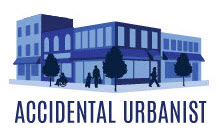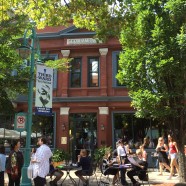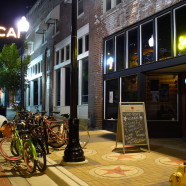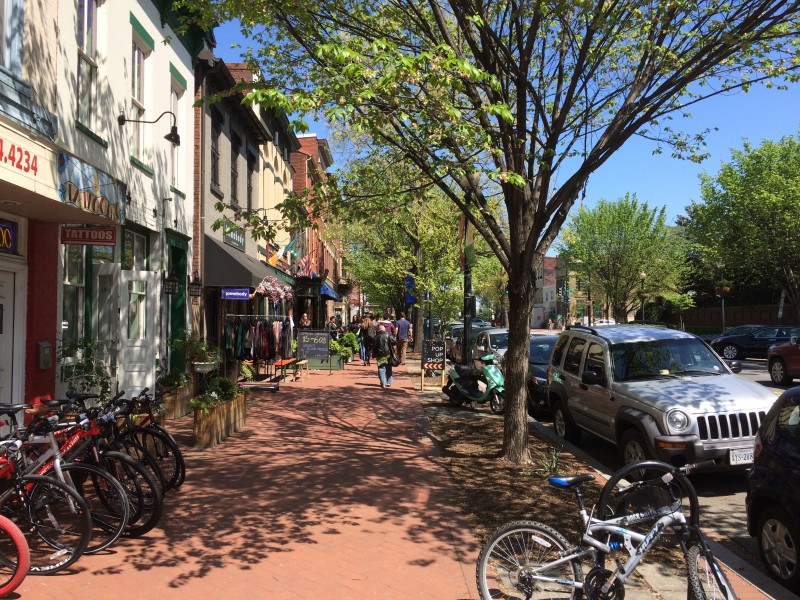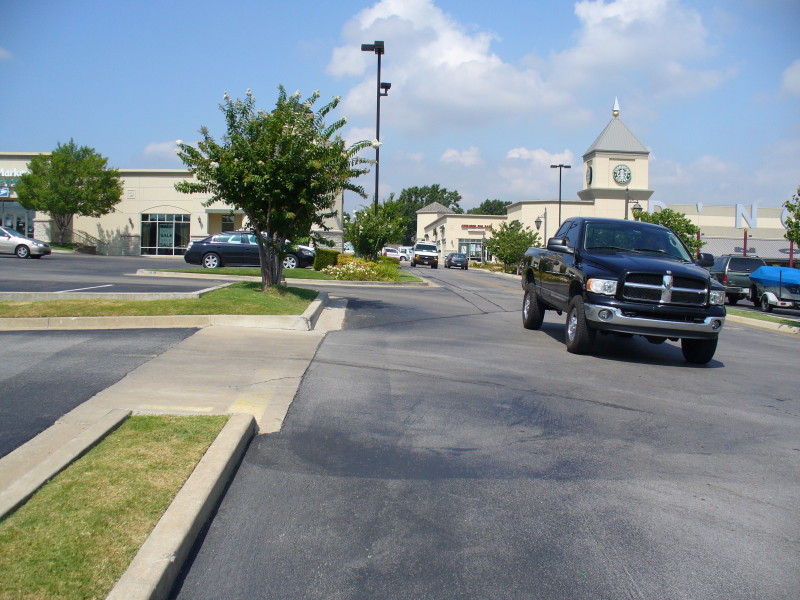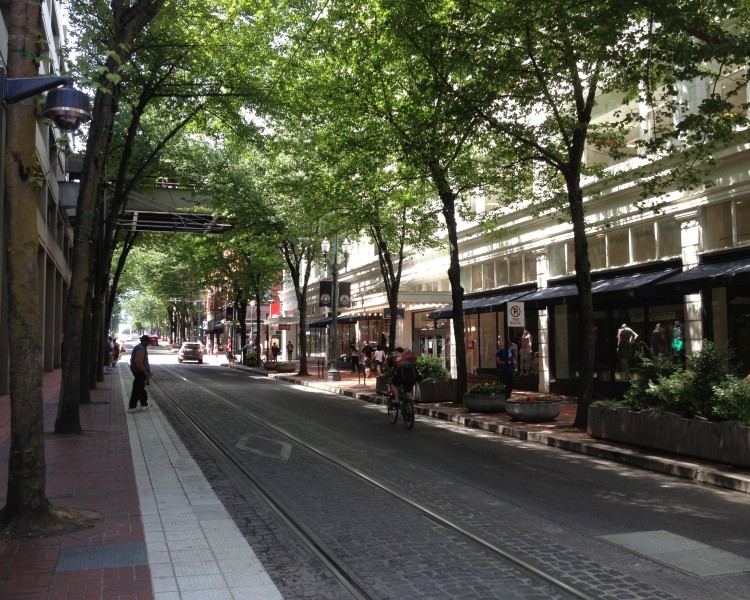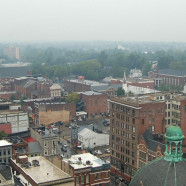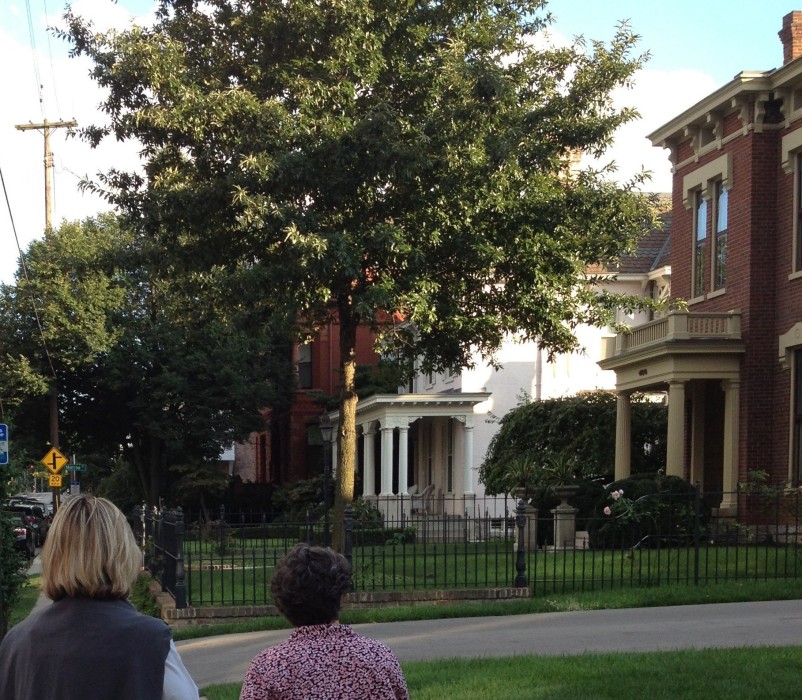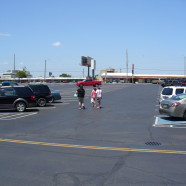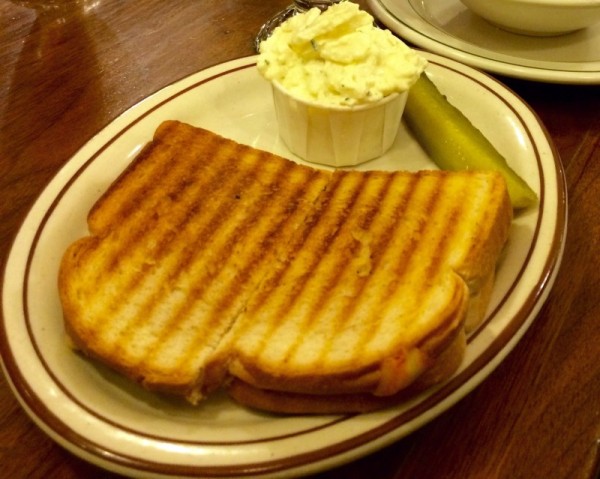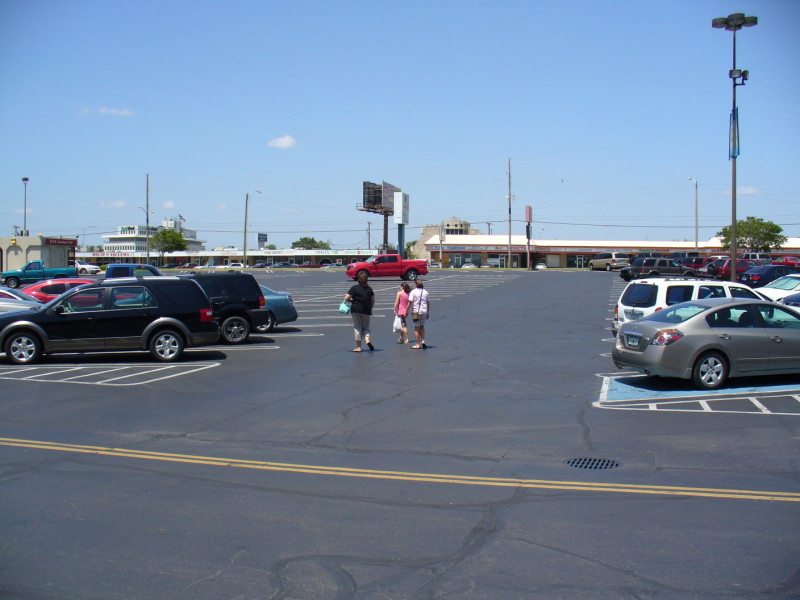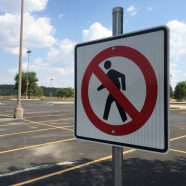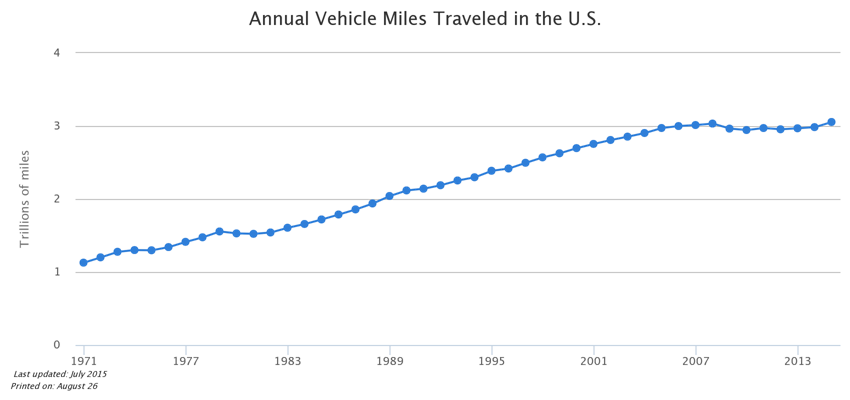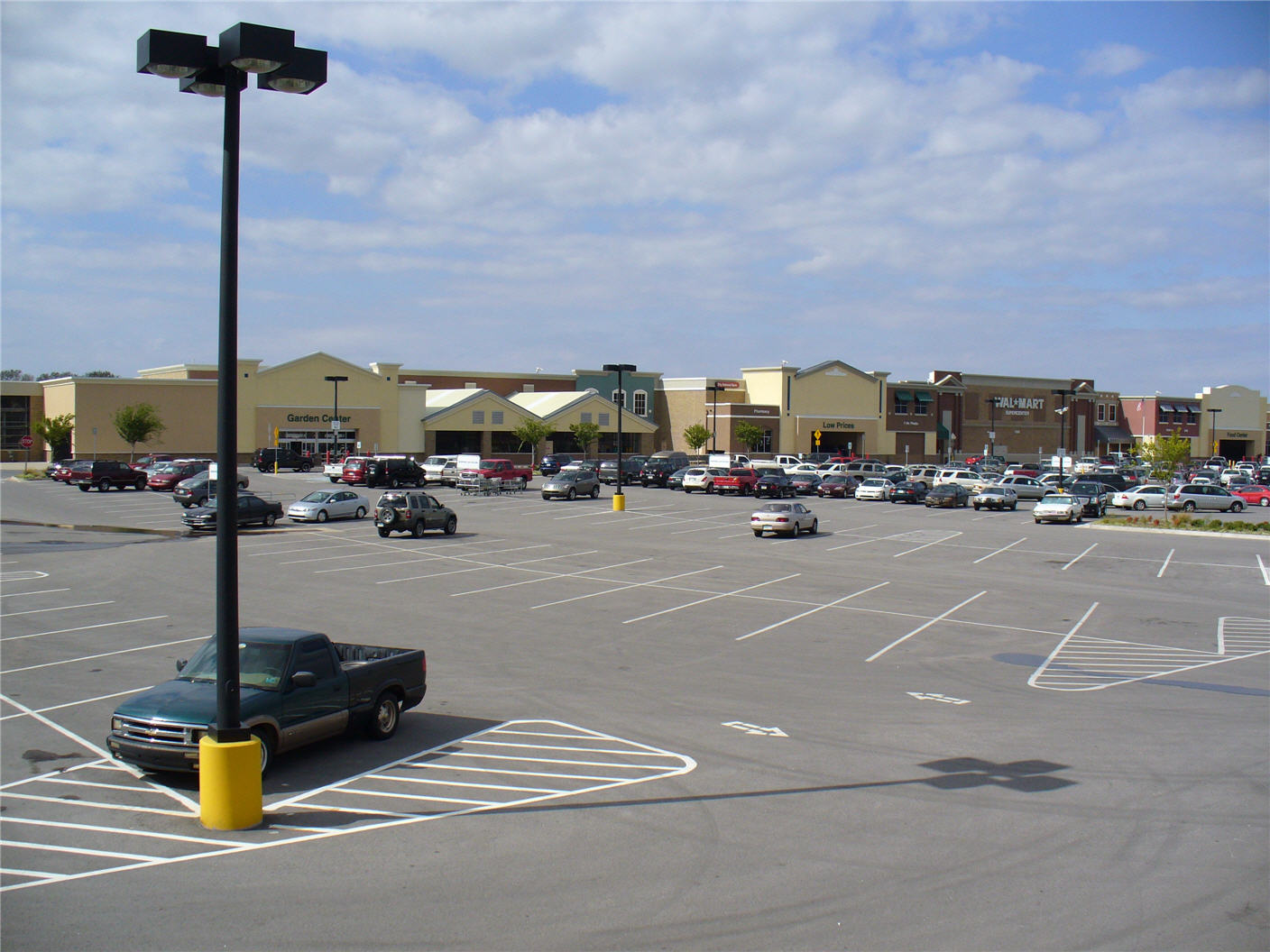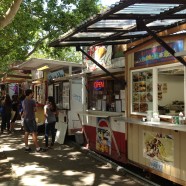Want Community? Build Walkability
Lately, I’ve been thinking about how our cities shape our habits and our lives.
Prioritize car travel and parking lots, and you get places where everybody drives. Build places where it’s delightful to walk, and pedestrians magically appear. Make it safe to bike, and cyclists come out of the woodwork.
Drop me in any location—like the “Street View” guy from Google Maps—and I can instantly tell if it’s a good place for people.
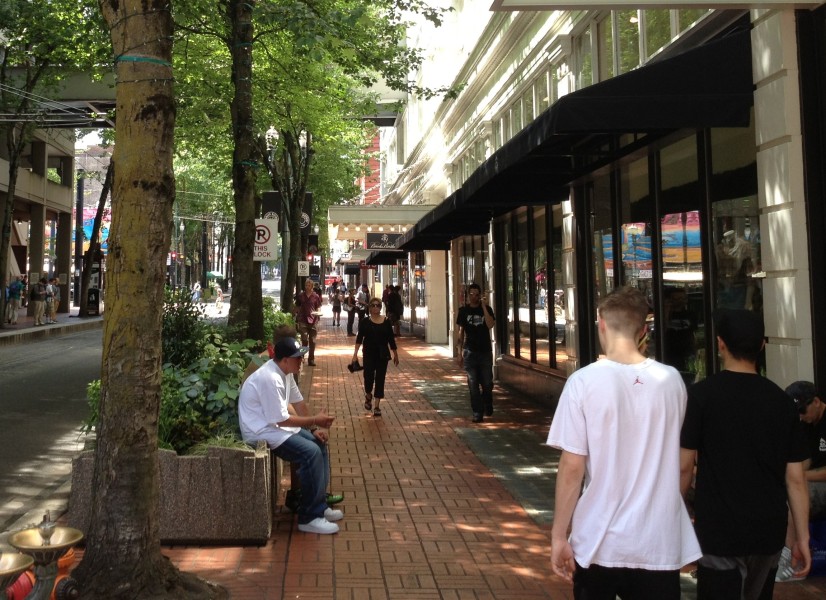
Are the streets narrow enough that drivers slow down and folks feel comfortable on foot? Are the buildings built up to the sidewalk, where pedestrians and transit users can access storefronts without coming into conflict with cars? Is the streetscape interesting to humans, providing a diversity of options and opportunities to explore? Do buildings have sufficient windows to breathe life into the street—allowing people on the outside to see in, and people on the inside to see out?
These are just a few of the variables that make places rich and inviting to people. And for the most part, we quit building them about 70 years ago. Not because people suddenly didn’t want to walk, bike and use transit. We basically regulated walkability out of our cities and towns.
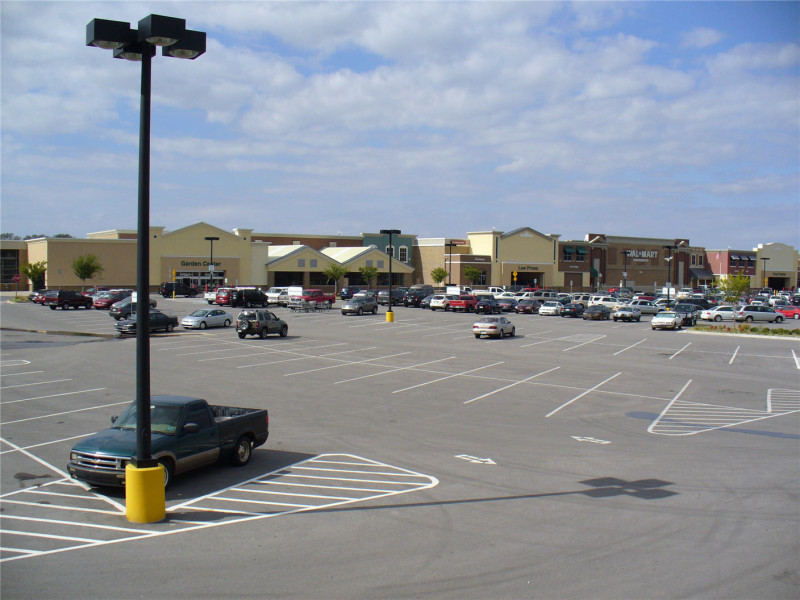
Municipal zoning ordinances separated commercial uses from residential ones, and enshrined car-oriented design at the local level. Transportation engineering standards transformed our city streets into high-speed stroads. Meanwhile, changes to lending practices and federal mortgage insurance regulations made it easy and cheap to get a loan on a single-family home in the suburbs, while making it significantly harder to finance mixed-use buildings in the urban core.
We pay for these mistakes with our bodies, as decades of car-centric design have transformed us from active humans into motorists reliant on machines for movement. But our communities also pay a price, as people who drive are more isolated and detached from the cities they call home.
I don’t mean to knock people who drive. (I live in a city where driving is often the only practical choice.) I simply mean that when you walk or bike, you experience your hometown in a much more intimate way.
NEIGHBORHOODS NEED EYES (AND EARS) ON THE STREET
A few weeks ago, while biking home from work, I was enjoying a long downhill stretch of road late on a Tuesday night. Catching all the green lights is a beautiful thing for a cyclist, and I was pedaling fast.
The sound of breaking glass stopped me.
I braked sharply and circled back, listening and looking for the source of the sound. Unfortunately, it appeared to be coming from the vacant Tulsa Club building, an art deco masterpiece that has suffered from decades of neglect and damage inflicted by vandals, fire, and an absentee slumlord. After many years and several false starts, it’s finally under new ownership and everyone in the community hopes this historic icon can return to its former glory.
Which is why it really ticked me off when I heard a second crash. Someone was either breaking in, or breaking windows for fun.
Without a moment’s hesitation, I was off my bike and yelling at them to stop.
I called the cops, and shined my bike light into the dark passageway between buildings while waiting for them to arrive. When the police showed up, I got back on my bike and headed home. But I kept thinking about what had happened.
If I’d been in my car, I never would have heard a sound. I wouldn’t have stopped, because I wouldn’t have known anything was wrong.
MORE THAN ONE WAY TO GAUGE A COMMUNITY’S HEALTH
When we talk about healthy communities, we often talk about economic prosperity, access to fresh produce, or chronic disease among populations.
But there’s more than one way to gauge a community’s health, and it’s not about dollars or waistlines or longevity statistics. It’s about engaging in your community and being a part of the world around you.
Every time I walk or bike, I enter into this world on a much deeper level.
When I bike to work, I speak to strangers. People say hello. They ask directions. They comment on the weather. At a minimum, I get eye contact and a wave. More often than not, people smile.
Over time, you start to recognize people: The doormen at the downtown hotel. The folks at the bus stop. The kids on bikes delivering sandwiches to office workers. The crossing guard at the elementary school. The homeless guy soaking in the sun on a warm winter day.
As people start to recognize you, the smiles get bigger, and the hellos get friendlier. You start to feel that we’re all in this thing together. Every time it happens, it makes my day. Every time, I feel a part of something bigger and better than myself. Maybe that’s the definition of community.
TRADITIONAL BUILDING PATTERNS BRING PEOPLE TOGETHER
Two things are at play here. One, I’m on my bike. I’m recognizable as a human being. I’m not encased in a soundproof bubble of glass and steel.
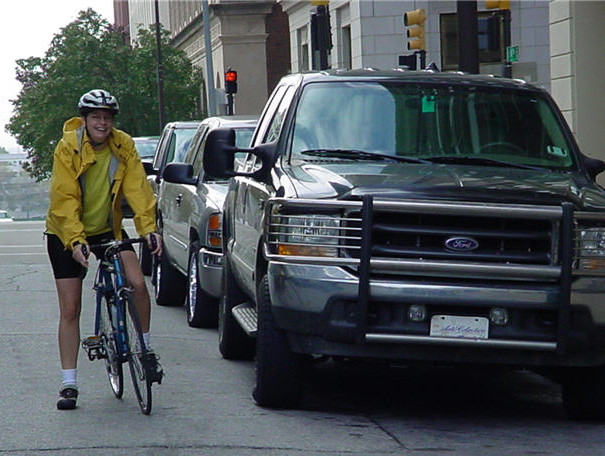
Two, my route to work takes me through older neighborhoods into the heart of downtown. I pass homes and schools and offices and shops, all of which are easily visible from the street. Houses and storefronts are built closer to the street, and there are a lot more people on foot. We’re close enough to recognize each other, and it’s possible to speak.
I rarely bike through places where single-use buildings are fronted by giant parking lots. If I did, I wouldn’t interact with nearly as many people. In these places, I would only interact with cars—which is a lot more dangerous for cyclists and a lot less fun.
But the way we build our cities impacts more than just cyclists. Over the years, I’ve come to believe that older, more traditional development patterns are actually safer and better for everyone.
When buildings “face” the street and meet the sidewalk, not only does it put “eyes on the street,” but walkable places create more opportunities for people to meet, to speak, and to care about each other.
When houses have front porches instead of backyard decks, people are more likely to know their neighbors, at least by sight, and they will notice if anything unusual is happening in the vicinity.
When people live above commercial spaces in mixed-use buildings, they “activate” the space both night and day. The area never feels abandoned, because people are always around.
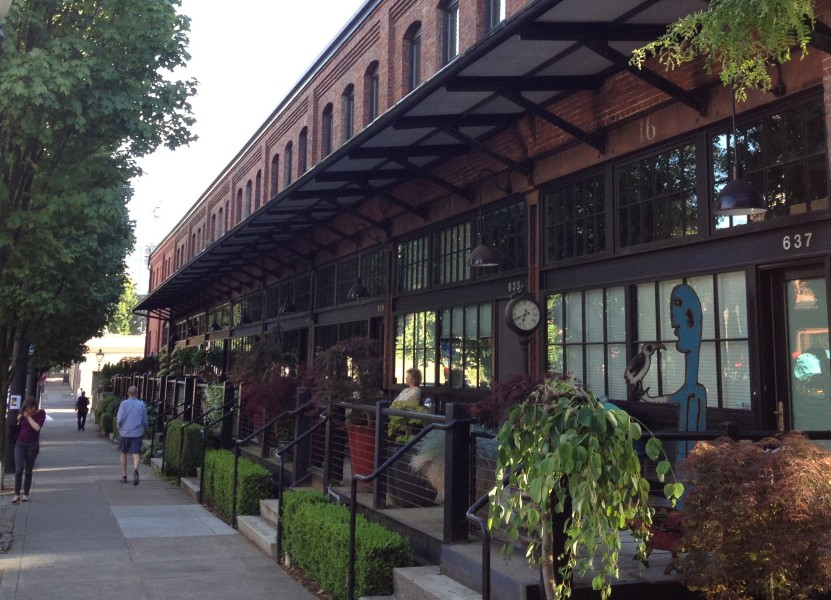
CONTRAST THIS WITH THE SUBURBAN MODEL
In a typical suburban neighborhood, people enter their vehicles within the protective shroud of their garage. They drive to their destinations without speaking to anyone who’s not already on speed dial. They park in enormous parking lots, where they may see other humans, but their main focus is avoiding being run over by an SUV. Later, they return home, where the garage door closes behind them like the drawbridge of a medieval castle. Outdoor activities take place behind privacy fences, and yards are so large that people who can afford to pay others to mow the lawn for them. Neighbors rarely have occasion to speak, and often don’t even know each other’s names.
This doesn’t sound like the American dream to me.
When we stopped building traditional, walkable places, we lost something important: the chance to have routine, face-to-face contact with strangers; and the opportunity to see and know and learn from people who are not exactly like us. In addition, we’ve decimated the kinds of neighborhoods in which people can easily look after each other.
What we’ve done is not good for our communities. It’s probably bad for our souls, too.
I can’t help but believe that our neighborhoods, our cities, and our commitment to each other would improve if more of us lived in places where “bumping into someone on the street” doesn’t involve heavy traffic and a fender bender.
To get there, changes are needed. We need to fix our zoning codes to enable traditional mixed-use neighborhoods. We need to challenge our transportation policies and stop prioritizing car travel over all other modes. And we need to eliminate the regulatory obstacles that make it difficult to obtain financing for renovation or construction of small, mixed-use buildings in walkable neighborhoods.
Cities evolve. We create our future one building at a time. So there’s no time like the present to start building–and rebuilding–places that are great for people and communities (again).
Read MoreAt the Intersection of Fiscal and Physical Health
It’s that time of year again. That brief, exuberant period in January, when gyms are crowded with people whose New Year resolutions haven’t yet expired on Super Bowl Sunday.
Since everyone’s focused on fitness, it seems like the perfect time to talk about healthy cities.
And whether you’re talking about a city’s fiscal health, or the physical health of its citizens, the same rules apply. In fact, you can easily determine if your neighborhood is a fiscally/physically healthy place by answering one, simple question.
When you’re on foot, does it feel good?
That’s it. That’s all you need to know. And here’s why.
When you’re walking and a place makes you feel good, certain conditions are being met. You are probably experiencing a sense of comfort, connection, discovery and delight.
Older, historic parts of town tend to get this right. Here you’ll find interesting architecture, human-scaled buildings, a diversity of destinations, narrow streets, and lively sidewalks.
Because our ancestors traveled on foot, they built for people, and it shows.
Contrast that with how we build today.
If this picture makes you feel exposed, unsafe, disconnected and anxious…congratulations! You’re human! If you think a lot of space is being wasted, you’re also correct. And if it you would never choose to walk to this destination, you’re not alone.
Which gets us back to the connection between fiscal and physical health, and the magic of traditional development patterns.
Those old geezers really knew what they were doing.
If your town has an intact, historic Main Street, then you have a terrific example of what I mean by traditional development. These neighborhoods weren’t planned to meet a single purpose for a single developer (for example: “regional shopping center”). Instead, they grew up organically over time to meet the varied needs of many different people, all of whom lived nearby and traveled on foot.
And because these places were built before car-centric development became a fad, they are much more efficient at utilizing space.
In traditional neighborhoods, buildings abut the sidewalk, and narrow storefronts stand shoulder to shoulder along the street. This eliminates wasted space and shortens the distance between destinations. It also creates the perfect environment for window shopping. Meanwhile, two- and three-story buildings allow a mixture of uses, while doubling or tripling the amount of usable space on modest-sized parcels of land.
As it turns out, these unassuming little Main Streets are turbo-charged economic engines that generate an incredible amount of tax revenue per square foot. And because they utilize space so efficiently, it costs a lot less to provide and maintain the public infrastructure they require.
And then there’s the alternative.
Compare that to the super-sized, asphalt wastelands that comprise 99% of all new development today. Single-story, single-use developments that are spread apart by great distances result in far higher public infrastructure costs while generating a lot less tax revenue per square foot of land.
This is the modern development pattern that Chuck Marohn calls the Suburban Experiment, and it’s crippling municipalities.
But it’s not just bad for your city’s bottom line.
All that waste is bad for your waist, as well.
Why? Because those very same factors that make car-centric developments terrible for city coffers also make them bad for your physical health.
Meanwhile, the very qualities that make traditional developments efficient economic generators also tend to create neighborhoods where you can easily use your muscles to get from place to place.
Where would you rather walk or bike?
Here?
Or here?
All that free parking is making you fat.
There’s a word for our modern, suburban style of car-centric development: “obesogenic,” which literally means “tending to cause obesity.”
We don’t simply create places where people aren’t encouraged to walk. We create places that punish people who try.
Wide streets with fast moving traffic make drivers happy, but they’re deadly to pedestrians. Buildings located far from the street provide lots of space for parking, but make it impractical for people to walk, bike or use transit to reach their destinations. (They also create asphalt moonscapes that are inhospitable to humans and lousy for the environment.) Separation of uses–like segregating residential from commercial, and office from retail–means that everyone must travel even further to meet their daily needs.
These are places where only the most desperate individuals venture forth without the protective carapace of a car. But you can’t blame folks for driving. In these environments; it’s often the only rational choice.
And yet, when you place those very same people in neighborhoods that were built for folks on foot, an amazing thing occurs.
People walk.
And when people start walking and biking, even to run a few short errands, another magic thing happens. Suddenly, they get the recommended 30 minutes of daily exercise, without even trying.
Because when you live in a walkable place, you don’t just run errands, you burn calories. You also increase your brain function, reduce the risk of chronic disease, strengthen your muscles, improve your balance, shrink your waistline, and extend your life.
But beyond that, when people get out of their cars, they connect with people.
Instead of your daily commute being a time of stress and frustration, you get some fresh air and sunshine. You cross paths with people and smile. You speak to strangers. You open your life to happenstance and serendipity. You notice beauty.
And you never have to go to the gym.
Read MoreAre You an Accidental Urbanist?
Somewhere along the way, I became an urban design nerd.
I’m fascinated by cities: how they’re built; how people get from place to place; and, most importantly, how I feel as a human being in that space.
My hobby drives my friends crazy. I’m constantly babbling about sidewalks, pocket parks, street widths, setbacks, parking requirements, and protected bike lanes. Also, I use the word “fenestration” in sentences.
In case you’re wondering (I know, you’re not) fenestration refers to the openings on a building–windows, doors, etc. It’s the thing that allows window shopping and people watching to occur. And it’s super critical to successful neighborhoods and streets.
But I digress.
As a kid, I was fascinated by old things. I loved old houses, old buildings, old objects, old people, and old ways of doing things. But I didn’t start thinking about cities, per se, until I found myself living in downtown Lexington, KY one summer during college.
Suddenly, a new world opened up before my eyes.
It was the first place I’d ever lived where walking was a valid form of transportation. Because Lexington was founded in 1775 and came of age in the 1800’s, it developed during a time when streets and neighborhoods were built for people who walked.
Here was a place where you could step out the door and stroll to an infinite variety of destinations. Parks, shops, restaurants, bars, schools, hardware stores…everything was within walking distance. Better yet, every step of the way was beautiful and interesting.
Because here’s the thing: when you’re walking, beauty matters. You notice details. You care about architecture. You stop for flowers. You laugh at quirky window displays. You appreciate art.
The result? Places built for people who walk are better places.
In the olds days, we got this right by default. We traveled at a walking pace and cities were built to satisfy the needs of people.
Although we’ve spent the past 60 years designing our cities primarily for the movement and storage of automobiles, we know there’s a better way. We can see it in our historic city centers and older neighborhoods. And we see it in newer developments where people cherish a sense of place.
So let’s talk about what it takes to make cities and neighborhoods great again.
You might discover that you’re an Accidental Urbanist, too!
Read MoreDoes That Parking Space Come with Fries?
Imagine living in a city where every restaurant is required by law to provide free chicken sandwiches. In addition to the free sandwiches, each restaurant offers a complete menu of items available for purchase. You can order roast beef or a reuben or an Albuquerque Turkey—but you have to pay for them.
The chicken sandwiches, however, are always free. And each day, restaurants must provide more than twice as many chicken sandwiches as their customers will eat. A majority of the sandwiches go to waste.
This would be absurd, right? What kind of communist plot would require a business to offer sandwiches for free?
Well, nearly every town in America does it. But they don’t require free sandwiches, they require something much more valuable: free parking.
But we need free parking…don’t we?
Even if they’re located next to a bus stop, or a bike route, or a residential neighborhood where their customers live, businesses across America must purchase extra land to build parking lots. Often, they must demolish existing buildings to do so. And while zoning ordinances don’t specifically require the parking to be free, we’ve built so much of the darn stuff, we’ve devalued it. People have come to expect free parking wherever they go. As a result, it’s a rare business that dares to charge for parking.
I’m sure you’re thinking: but we need all that parking! Everybody drives to the store!
It’s true, lots of folks drive. Why? Perhaps it’s time to revisit that town with the free sandwiches.
If chicken sandwiches are offered for free (while every other item on the menu costs money) what does that do to demand?
I think it’s fair to say that a lot more folks would eat chicken sandwiches in our imaginary town, even if they preferred pastrami on rye. Because a free sandwich is a free sandwich!
“A fertility drug for cars.”
In much the same way, when we require abundant off-street parking, but we don’t require infrastructure that supports transit, cycling or walking, we impact demand. Our zoning code essentially dictates that developments prioritize cars over people. So what do we get? A city full of cars.
As Donald Shoup famously wrote, “Minimum parking requirements act like a fertility drug for cars.”
And because we put the needs of cars before those of people, we require buildings to be set back far from the sidewalk. We require enormous parking lots located between the building and the street. We expect pedestrians and transit users to traverse asphalt wastelands and share space with speeding SUVs.
We make driving convenient and seemingly “free.” We make every other alternative inconvenient and unpleasant, and then we charge for transit. We are handing out the chicken sandwiches and wondering why so few people choose soup or salad.
But is all this parking actually “free?”
(The true cost of car ownership is a topic for another day, so let’s just focus on parking.)
Back to our imaginary town…
To offset the cost of free chicken sandwiches, restaurants would need to increase the price of every other item on the menu. Drinks, soups, salads, burgers—every other item would cost more because the chicken sandwiches were free.
It’s the same with parking: we all pay for it–whether we drive or not.
We pay because the price of goods and services includes the cost of all that free parking.
Gratuity included. Hidden fees may apply.
As communities, we pay because abundant parking makes land less productive. More asphalt means fewer businesses, fewer jobs, and fewer tax dollars per acre.
In addition, our tax dollars are spent to build and maintain roads so all those cars can travel from one “free” parking space to another. And the more parking you require, the further everyone must drive. Businesses and destinations are separated by great distances because of the space needed for parking.
Spreading out these destinations means that our tax dollars must fund additional miles of roadway. We also must provide and maintain more water, sewer, and stormwater pipe; more pumping stations; more fire stations; more police officers…. You get the idea.
It’s an inefficient system, and it needs to stop.
Since 1963, the population of the City of Tulsa has increased by about 30%. In this time, our city’s geographic area has expanded by approximately 300%. Most of this growth has come in the form of low-density, inefficient, suburban sprawl.
Thanks to parking minimums, approximately 2/3 of our commercial space is covered in asphalt. The remaining 1/3 of the commercial land cannot possibly generate all the taxes, jobs and commerce needed to support our city’s needs. We have built a lot of infrastructure for so few taxpayers.
And it makes for an awfully expensive free sandwich.
Read MoreUnhealthy by Design
For the first time in our history, we are raising a generation of kids who will have a shorter lifespan than their parents.
Take a moment and let that sink in.
It’s a startling fact.
Historically, the challenge for public health officials was the fight against infectious diseases. In 1900, the leading causes of death included pneumonia, tuberculosis, and some nasty intestinal maladies I’d rather not get into. (No need to gross everyone out.) Let’s just say that no amount of Pepto Bismol was going to help.
Happily, we spent the 20th century developing solutions to these problems. We created clean water and sanitary sewer systems. We developed antibiotics and immunizations. We learned about the importance of proper ventilation, hygiene and sanitation practices. Combined with increased worker and consumer safety regulations, these changes added 25 years to the average American’s lifespan.
Today that lifespan is decreasing. And now we have a totally different public health crisis: chronic diseases linked to inactivity and obesity.
In 2014, the leading causes of death were heart disease, cancer, lower respiratory disease, and stroke. Although diabetes is 7th on the list, the number of people with diabetes has tripled since 1994 with no end in sight. It’s estimated that by 2030—if trends don’t improve—more than 80% of Americans will be overweight or obese.
The Evolution of Inactivity
So what changed? Why, despite advances in drugs and medical procedures, are people less healthy today than 20 years ago? Why, despite all our focus on diet and healthy eating, are we gaining weight?
One major factor is the amount of physical activity we get.
Since 1994, the number of Americans reporting absolutely NO physical activity has increased from 17% to 52%.
Which just happens to be directly related to the amount of time Americans spend sitting in their cars.
Since 1980 the number of vehicle miles traveled has doubled.
If you look at the way we design our cities it’s no wonder. We’ve spent the past several decades prioritizing the needs of cars over the needs of people. We’ve designed inactivity and auto-dependence into our daily lives.
Convenient for Cars; Deadly for Humans
Instead of wide, tree-lined sidewalks and bike lanes, we get multi-lane roads designed for high-speed travel by automobiles. Instead of corner cafes and coffee shops, we get drive-thrus in the middle of asphalt oceans. Instead of buildings lining our main streets, we get businesses that are pushed back behind an obscene display of surface parking. Instead of homes on modest sized lots with connected street grids, we have giant yards on cul-de-sacs. And instead of building housing near schools, shopping and jobs, we separate each use—as if in fear of cross-contamination.
Our cities have been evolving to meet the needs of automobiles for over 50 years. Unfortunately, our bodies have evolved over a much longer period for a different purpose.
The human body is designed for action. We’re built to walk. We’re meant to be active. And while we’ve become more and more sedentary in recent decades, our inactivity comes at a cost.
If you need hard facts, try this one on for size. According to the American Diabetes Association, the cost of diabetes (direct medical costs and reduced productivity) has risen from $174 billion in 2007 to $245 billion in 2013, a 41% increase in just five years.
The Human Habitat
If we want to change our habits, we’re going to have to change the way we design our human habitats.
We’re going to have to start building places that are great for walking, biking and transit. We’re going to have to put the needs of people above the needs of automobiles.
The Urban Land Institute has put together a toolkit for “Building Healthy Places.” It includes a list of common sense solutions to help make our cities and towns healthier places to live. These include old-fashioned ideas like:
- Incorporate a mixture of land uses (don’t separate everything from everything else)
- Design well-connected street networks at the human scale (make it easy to get from place to place without a car)
- Provide sidewalks and enticing, pedestrian-oriented streetscapes (don’t punish people for walking)
- Provide infrastructure to support biking (burn calories, not gas)
It’s a great place to start the conversation. Other resources include The Center for Active Design and 8-80 Cities.org.
Americans need to get active. The beautiful thing about thoughtful urban design is that the activity is baked into your day. You don’t need a gym membership if you can bike to work or walk to dinner.
Now that’s food for thought.
Read MoreSigns That You Might Be an Accidental Urbanist
You might be an accidental urbanist if…
…you care more about people than cars.
…you enjoy walking to dinner or window shopping.
…you like kids and old folks.
…you care about your health, and hope to live a long and active life.
…you think trees are more beautiful than asphalt.
…you care about schools and believe in public education.
…you appreciate parks.
…you like to ride your bike.
…you care about your neighbors.
…you treasure the craftsmanship of historic buildings.
…you believe that your community matters.
…you realize that some places just feel right, and make you want to be there.
